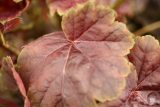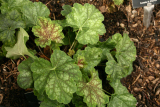Additional notes (click to expand)
Commemorative
These North American woodland plants, locally called Alum Root, are named after Johann Heinrich von Heucher (1677–1747), professor of botany and medicine at Wittenburg University (1709), Germany, and later in Dresden. Von Heucher was physician to King August II of Saxony. He was the founder of the botanic garden in Wittenburg and author of Novi proventus horti medici Academiae Vitembergensis (about the botanic garden) (1711). He was elected a fellow of the Royal Society in 1729. Most cultivars are derived from Heuchera americana
Oakeley, Dr. Henry. (2012). Doctors in the Medicinal Garden. Plants named after physicians. Royal College of Physicians.
link
Horticulture
We grow the Heuchera cultivars, Heuchera Plum Pudding’, Heuchera ‘Silver Scrolls’ and Heuchera ‘Velvet Night’. They are semi-evergreen, hardy perennials in the family Saxifragaceae. The genus originates from North America and Mexico. They have attractive marbled, silvery or mottled lobed leaves and delicate, bell-shaped flowers, which form an eye-catching ground cover
when planted en masse. We grow them in a raised bed of moist, free draining soil in partial shade. They do not like dry conditions so we water in dry spells and mulch with well-rotted manure in early
spring avoiding the crowns. When the foliage becomes untidy, it can be cut down and will soon be replaced by new growth. (Clare Beacham)
Oakeley, Dr. Henry. (2012). Doctors in the Medicinal Garden. Plants named after physicians. Royal College of Physicians.
link
Medicinal
Chickasaw medicine. Root used as a powerful astringent.Root used as a tonic.
Campbell, T.N. 1951 Medicinal Plants Used by Choctaw, Chickasaw, and Creek Indians in the Early Nineteenth Century. Journal of the Washington Academy of Sciences 41(9):285-290 (p. 286,287)
Menominee medicine. Compound decoction of root used for stomach pain. Raw root eaten for "disordered stomach."
.
Densmore, Francis 1932 Menominee Music. SI-BAE Bulletin #102 (p. 130)
Meskwaki medicine. Foliage used as an astringent for sores.Compound containing root used as a "healer."
Smith, Huron H. 1928 Ethnobotany of the Meskwaki Indians. Bulletin of the Public Museum of the City of Milwaukee 4:175-326 (p. 246)
Cherokee medicine
Powdered root used on malignant ulcers and infusion sprinkled on bad sores. Infusion of astringent root taken for bowel complaints. Taken for dysentery.Used for "immoderate flow of menses."Infusion of root taken for piles.Infusion used for "thrash" and sore mouth and root chewed to take coat off tongue.
Hamel, Paul B. and Mary U. Chiltoskey 1975 Cherokee Plants and Their Uses -- A 400 Year History. Sylva, N.C. Herald Publishing Co. (p. 23)
Neither Austin (2004), Milspaugh (1974) nor Moerman (2009) record any uses by the Native Americans, but Henriette’s herbal website, quoting King’s American dispensatory (1898), says it is used to check diarrhoea, haemorrhage, skin ulcers, and as a pessary for vaginal discharge.
Oakeley, Dr. H.F. (2013). Medicines from RCP plants label list 5-2013.docx. p. 84
Other use
Neither Austin (2004), Milspaugh (1974) or Moerman (2009) record any uses by the Native Americans, but Henrietta’s Herbal website, quoting King's American Dispensatory (1898), says it is used to check diarrhoea, haemorrhage, skin ulcers, and as a pessary for vaginal discharge.
Oakeley, Dr. Henry F. (2013). Wellcome Library notes.
link
Toxicity
No special toxicity described
Professor Anthony Dayan, 2022
Geographical distribution
- Northern America, Northeastern U.S.A.
- Northern America, Southeastern U.S.A.
Heuchera americana L.
Family: SAXIFRAGACEAEGenus: Heuchera
Species: americana L.
Common names: Alumroot
Distribution summary: East U.S.A.
Habit: Perennial
Hardiness: H5 - Hardy; cold winter
Habitat: Woodlands
Garden status: Currently grown
Garden location: North America (A)
Reason for growing: Commemorative, medicinal
.JPG)


